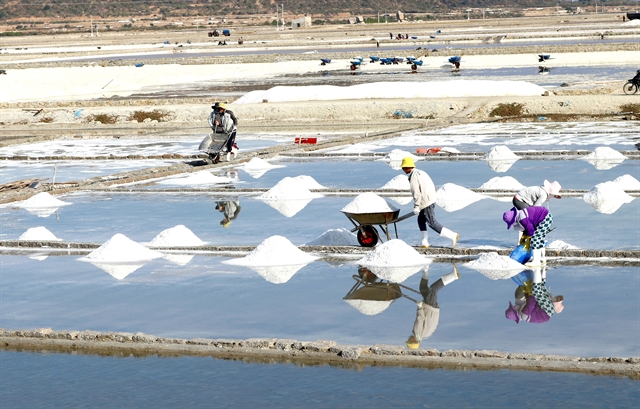 Society
Society

 |
| Farmers harvest salt in Ninh Thuận Province’s Ninh Hải District. – VNA/VNS Photo Nguyễn Thành |
NINH THUẬN — The south-central province of Ninh Thuận is increasing the use of advanced techniques for salt production to enhance quality and value and meet the requirements of domestic and export markets.
With a coastline of 105km and high salinity rate in its seawater, the country’s driest province has favourable conditions for producing salt, mostly in Ninh Hải and Thuận Nam districts.
In the past salt farmers used the traditional method, which normally took a month as water obtained from the sea dried in the sun leaving behind salt.
It was cheap but the salt was impure, and farmers normally sold their harvest immediately for low prices in the peak season.
To improve quality and farmers’ incomes, local authorities encouraged them to switch to other techniques and establish co-operatives and co-operative groups to ensure outlets and steady selling prices.
One of them involves using plastic sheets to cover the earth to produce cleaner salt.
Trần Văn Lan in Ninh Hải District’s Trí Hải Commune uses plastic sheets and said: “Salt produced using plastic sheets has higher quality and bigger grains, is whiter and drier than salt produced using traditional methods.”
The cost of sheets to cover 1,000sq.m of field is around VNĐ100 million (US$4,300).
Salt produced thus is preferred by refining companies since it is clean.
More and more salt farmers in the province are linking up with co-operatives.
Mai Ngọc Minh in Ninh Hải’s Phương Hải Commune has a 1.5ha salt field and produces 90-100 tonnes a month during the dry season.
He used to sell to traders but now to the Phương Hải Salt Co-operative at a higher price, he said.
“This [higher income] enables me to have more money to invest in salt production.”
According to Trần Ngọc Chiến, director of the Phương Hải Salt Co-operative, the commune has 90ha of salt fields and the co-operative has tied up with more than 40 households with more than 40ha.
It procures 2,000-3,000 tonnes a month and pays steady prices for it.
It provides financial support to farmers to build roads in their salt fields to make transportation easier and buy plastic sheets.
The province has two salt co-operatives and one co-operative group and 3,078ha of salt pans, which produced 195,050 tonnes of salt in the first half of this year, according to its Department of Agriculture and Rural Development.
Salt produced using the traditional method fetches VNĐ600-900 a kilogramme while farmers using plastic sheets get VNĐ1,000-1,200 for their product.
The province currently has eight companies that refine 80,000-90,000 tonnes of salt annually, mostly for selling domestically.
The province is one of the country’s largest salt producers but has the potential for increasing production and processing by a great deal, according to the department.
Under a government plan, Ninh Thuận will have 3,267ha of salt pans and an annual output of 650,000 tonnes by 2030.
Trương Khắc Trí, deputy director of the department, said to meet these targets the province planned to reorganise and rezone production, increase the use of machines in salt production, and use advanced technologies to monitor seawater salinity, radiant heat and wind.
More farmers would be taught advanced techniques and given soft loans, he said.
There would be policies to help farmers switch from traditional to industrial methods to improve yields and quality.
It would develop brand names for salt products and undertake trade promotion activities to ensure stable incomes and livelihoods for farmers. — VNS




